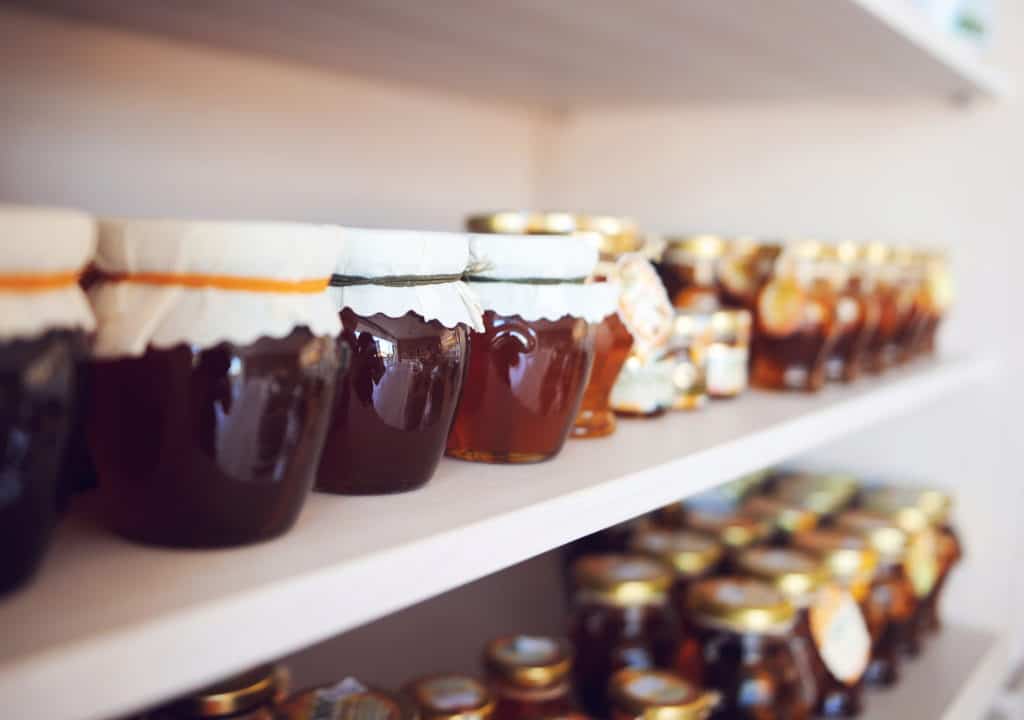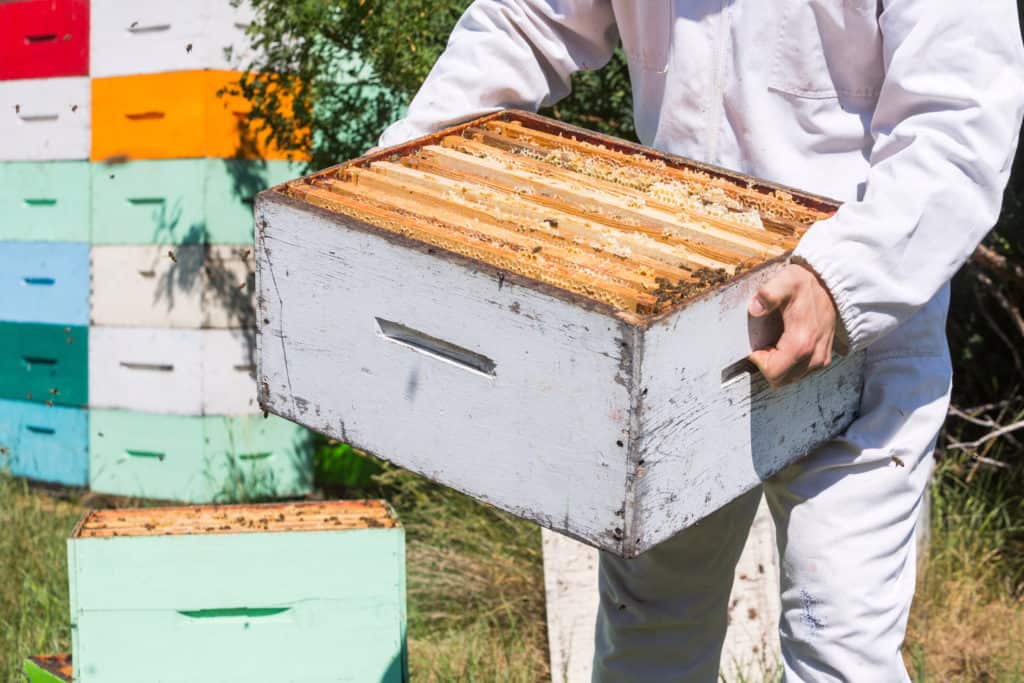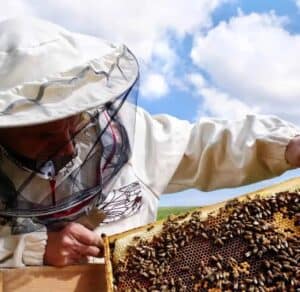How Many Beehives Does It Take To Make A Living? Is This Realistic?
Beekeeping is such an enjoyable and rewarding experience that most beekeepers, especially new beekeepers, wonder if you could actually earn a full-time income doing it. Is it really possible to become a profitable full-time beekeeper and if so, how many beehives does it take?
It would take at least 500+ beehives to make a full-time living as a beekeeper. It would take a diversified approach and not just solely relying on honey production. It is recommended to grow slowly to gain experience and to scale properly by implementing strong bee management techniques.
To become full-time beekeeper requires a lot of experience, money, planning, and sound bee management strategies. I’ll explore the different factors you should consider as you plan to make a living as a beekeeper.
How Many Beehives To Make A Full-Time Income

Most beekeepers only start beekeeping as a hobby because of general interest, to help pollinate their garden or farmland, or to have a positive impact on the environment. But then realize they could possibly make money doing a hobby they enjoy.
To make a reasonable income as a beekeeper requires a person to have a very good understanding of bees and different management methods. You really need to learn the craft of beekeeping before deciding to make a full-time income raising bees.
You will read a lot of articles and information stating that you can make a fulltime income if you have around 200 hives. But realistically, most beekeepers even with 200-300 hives are not able to rely on beekeeping profits as a full-time income. They still require another job or some form of secondary income.
Now, not everyone has the same income requirements or goals. One person may only want to make $40,000 a year from beekeeping while another may want to make $80,000 a year. But both income requirements will require a lot of beehives, workload, equipment, land, and bee management.
Most beekeepers will focus on honey production because it is the most obvious by product of beekeeping. I would caution you to build slowly and take a more diversified approach when trying to make money from beekeeping.
And if you want some guidance on selling your honey, hold up for just a bit, I wrote an article all about how much money you can make selling your honey that I encourage you to read!
Realistically speaking if you take a more diversified income approach you could make a full-time living if you had between 500 to 1000 beehives. The key is to diversify your income because it is very difficult to make a living just from honey production.
There are several other ways to profit from your beekeeping efforts in combination with honey production that will give you a better chance to succeed.
In fact, one of the most popular and profitable methods is by selling bees, queens, and nucleus colonies. This does require you to slowly build a market for your bees, but it can be more profitable than honey production and quite a bit less work.
If selling bees is an income stream you’re really interested in, you’ll like this guide I wrote about how much money you can make selling nucleus colonies, packages of bees or queen bees that I also encourage you to read!
Here are some more alternative methods to make money as a beekeeper:
Beeswax – you can sell the beeswax, or you can use it to make and sell lip balm, soaps, candles, hand creams etc.
And if you want to start selling beeswax, don’t start selling just yet, check out this article I wrote all about how much money you can make from selling your beeswax!
Pollen and Propolis – you can sell bee pollen and/or propolis. This does sell for quite a bit of money and can be very profitable. You need to be careful with selling this product due to local pesticide and herbicide use.
And for some guidance on selling pollen and bee propolis, I wrote 2 helpful guides that I recommend you read: how much money can you make selling your pollen, and how much money can you sell your bee propolis for.
Bee Removal – you can offer bee removal services. This can be quite profitable with the possibility of getting some free bees for your apiary.
Royal Jelly – you can sell raw unprocessed royal jelly or the freeze dried royal jelly in powder form. It does sell very well and you can get a pretty high price. For more information check out this article I wrote all about how much money you can make selling royal jelly that I encourage you to read.
Apiary Maintenance – you can maintain other people’s beehives for them and charge a reasonable fee. It is not uncommon for people to setup hives in their gardens etc., and not want to learn or take the time to manage them correctly. Some people are more than happy to pay someone else to look after their bees.
Beekeeping Education – as you gain experience you can offer beekeeping classes and training.
Pollination Services – offering this service can be very profitable. A lot of beekeepers only offer pollination services and make a full-time income doing so. It does require a lot of beehives, equipment, and experience.
Raw Honeycomb – many beekeepers will sell this tasty treat alongside their raw honey. Honeycomb does sell for a higher price than honey and can be quite profitable. If you’re interested in selling your honeycomb, hold up for just a sec, I wrote a practical guide about how much money you can make selling your raw honeycomb that I would encourage you to read!
Buying Honey For Resale – Some beekeepers are successful with only a few hives because they understand the retail market very well. They will buy honey from local beekeepers and sell it as a profit in the retail market direct to customers. If you’re interested in this business model, I wrote an article all about how much money you can make buying honey and then reselling it that I would recommend you read.
Other beekeepers will solely focus on raising and selling bees, queens, queen cells, nucleus colonies and are very successful. Whereas other experienced beekeepers will only have a couple hives but sell beekeeping equipment and supplies or even places hives on other people’s property for a monthly fee.
The key is to keep an open mind on how you can make money as a beekeeper and a diversified approach is the key to becoming a successful full-time beekeeper.
How Many Beehives Can One Person Manage

The next logical question when considering raising bees as your full-time occupation is how many beehives one person can manage. The number of colonies one person can operate effectively is going to depend on if your focusing on honey production, raising bees or other profitable methods.
One person can manage between 100 to 150 hives while still working a full-time job. As a full-time beekeeper one person can manage between 500 to 800 bee colonies but would still require seasonal workers to assist with the honey harvest.
If your only raising bees for honey production, it becomes very difficult for one person to manage a lot of hives. Managing beehives solely for honey production is much more time consuming and harder work compared to just raising and selling bees. Further, honey production requires a lot more expensive equipment and supplies as you scale your apiary.
If your primary focus is on raising and selling bees it is easier to manage while you’re still working a full-time job. Experienced beekeepers will often manage 100-150 bee colonies successfully while maintaining a full-time job. But this does take time to gain experience, grow your apiary, and build a market to sell your bees.
The amount of time required to manage hives will also depend on the quality of your equipment, the distance to your bee yards, bee management style, and how much free time you have.
It is recommended to always start with 2 beehives and build slowly. This will give you an opportunity to see how much you enjoy beekeeping before making a large investment. You also need to learn the beekeeping craft which takes a conservable amount of time.
Most hobbyist and new beekeepers only maintain between 5 and 25 bee colonies. This is easier to manage, keeps their costs reasonable, and gives them more time to enjoy the hobby.
Once a person begins to manage 25+ beehives they are beginning to become more serious about their beekeeping. This now requires far more planning and being more efficient with their time. It also begins to get more expensive to purchase additional woodenware and equipment.
A major step in beekeeping occurs when a beekeeper grows to 70 to 100 colonies. At this point serious money is being spent on equipment for honey extraction, honey handling equipment, woodenware, a dedicated truck, and countless other things you will require.
Also, managing this many hives will take up most of your free time. You need to have good bee management system in place to look after that many colonies effectively.
The next significant step in beekeeping is when a person begins to manage 200 or more colonies. You can no longer just manage your bees in the evenings and on the weekends. This is usually the time when people begin planning on turning their efforts into full-time beekeeping.
The number of hives one person can manage will always come down to their experience, the quality of their equipment, their business model, and time management skills.
One person can manage up to 600 hives effectively if you’re business model is solely raising and selling bees, nucs, queens etc. But raising bees for honey production requires a lot more work and is more difficult to manage that number of hives by yourself.
One person could manage 400 to 600 hives for honey production, but you will require seasonal works to help with the honey harvest and extraction. If you are a honey producer, you will not be able to do all the work by yourself.
It will come down to how well you can streamline your beekeeping and management practices for that many hives, otherwise it will become unmanageable.
Beekeeping Profit Per Hive

How much profit can I make per beehive is another very common question among new beekeepers. To begin beekeeping requires a large investment into equipment, bees, and your own education. In the beginning you also don’t have a market to sell your honey or bees into. Your new and will have to establish yourself.
It’s also important to differentiate between honey profit per hive and honey income per hive. Your profit per hive will be the amount of income per hive subtracting your expenses per hive. Which as all new and experienced beekeepers know your expenses will be much higher when first building out your apiary.
It is recommended to start with 2 hives when you first begin beekeeping, and this will cost you between $1100 to $1200 for your initial setup. You should really budget for $2000 just in case you need to purchase other equipment or bees.
I have a breakdown of the costs to setup your first 2 hives and other important factors to consider here:
Is Beekeeping An Expensive Hobby? 19 Important Factors To Consider
You will not be turning a profit for the first several years with your apiary. Even if everything went perfectly into your second season of beekeeping and you sold some honey you would be very lucky to break even.
When first building your apiary it’s difficult to calculate profit per hive because you probably won’t have any profit. You will be incurring ongoing expenses as you expand and purchase more equipment. It will also take a few seasons of beekeeping to establish yourself to be able to sell your honey, sell your bees, or whatever business model you decide.
You often see the $100/hive profit number when discussing profit per hive numbers, but your mileage will vary depending on your business model. As I’ve mentioned early in this article your best option if you want to become profitable is to diversify. I would not recommend just relying on honey production as your sole profit center.
The current US national average honey prices for both retail and wholesale are listed below.
US Average Retail price is between $7.88 to $8.09 per pound.
US Average Wholesale price is between $4.89 to $5.05 per pound.
These prices are just the US national averages and are going to fluctuate considerable depending on your region, if you sell your honey direct to retail customers, the kind of honey your selling, and your marketing efforts.
But as you can see the average honey prices are not very high and honey production is a competitive market. This makes it very difficult for beekeepers to turn a profit solely relying on honey production.
Also, you’ll need to get a feel for your local honey market. There are beekeepers whom charge $20 per pound for their honey because they are able to successfully market their local honey.
They focus on marketing their honey as non-heated, raw honey, organically raised, from local foraging etc. Of course, I’m not sure how all honey isn’t considered “organically raised” but in any event it is used for successful marketing.
My point being it’s best to keep an open mind for where you can charge higher prices for your honey, offer other honey related products, and even sell some bees eventually. This will increase your odds of eventually turning a profit per hive in your apiary.
In the vary least you could stay as a hobbyist and possibly at least break even for a very fun and rewarding hobby.
There was an interesting study conducted by the NYS Beekeeper Tech Team. They evaluated nine local honey producers with fewer than 500 colonies.
They published a financial analysis of the business’s with results and management implications to create a Business Benchmark for beekeepers. This was done to assist future and current beekeepers in becoming successful business operators.
How Much Do Beekeepers Make A Year – Salary Based

In the United States beekeepers are classified as agricultural workers within the US Bureau of Labor Statistics at bls.gov. The beekeeper occupation is included in the salary numbers with farmers, ranchers, and agricultural managers. There is no specific beekeeper occupation listed with their own salary numbers.
The average US salary of a beekeeper is between $28,000 to $44,000 which is around $14 to $22 per hour. These numbers are based on agricultural workers in the US and their average salaries.
In some rare cases more experienced beekeepers working for a large apiary could make a management salary up to $65,000+ per year. But this level of salary is uncommon and requires a minimum of 5 years beekeeping experience. Again, this is also based on US salaries of agricultural managers.
A beekeeping salary, like any job, is very dependent on your experience and what region of the US you live in. It also depends if you’re just helping with the day to day beekeeping, basically a laborer, or your actually managing hives for someone’s apiary.
Unfortunately, there is no reliable breakdown of salaries specific to beekeeping since most beekeepers have their own bees as hobbyists or commercial operations.
Related Questions
How many times can you harvest honey in a year? Most beekeepers harvest honey 2-3 times per year/season. Honey is normally harvested between June until September. How often you harvest depends on your local climate and plant life. Poor weather conditions, disease and pests infiltrating your hives will also affect your harvesting schedule.
How long can you keep capped honey? You should only keep capped honey away from the hive for no more than 2 days. I recommend leaving your supers until you’re ready to harvest. By pulling frames to early, you increase the likelihood of getting bugs in your honey.
If you have no choice, a good option is to simply put your frames in a deep freeze. Once your ready to extract the honey, simply let them thaw for 2 days (sealed – keep bugs out) then extract your honey. This is a more common practice with hobbyists.

Joseph Davis
My goal is to show that anyone can take up beekeeping and it can be a very rewarding hobby. I strive to share my experiences and answer any questions you may have.
